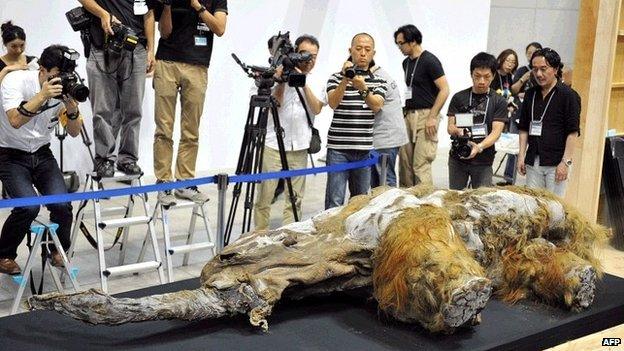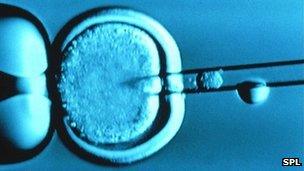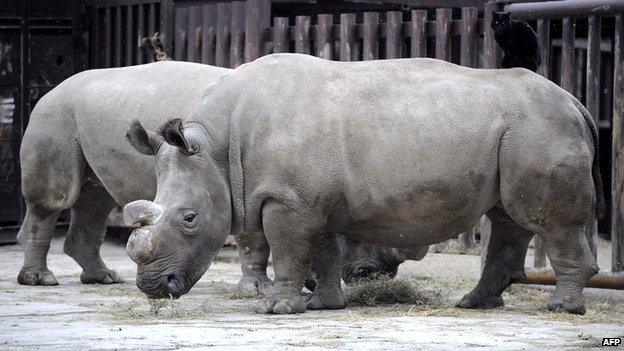De-extinction: Mammoth prospect, or just woolly?
- Published

Will we be able to marvel at a live one anytime soon?
Some scientists are now seriously considering the possibility of bringing back extinct animals. But can it be done, and if so, what would be the use?
The film Jurassic Park - based on a novel by Michael Crichton - is a rather cautionary take on the merits, or otherwise, of using technology to revive extinct species.
The movie, directed by Steven Spielberg, was released 20 years ago and tells the story of an eccentric billionaire who hatches the idea of a theme park populated by cloned dinosaurs.
Needless to say, it all goes horribly wrong, leaving the protagonists to fight for their lives against voracious velociraptors and a fearsome Tyrannosaurus rex.
The basic science that originally inspired the story has matured to the point where some scientists are now seriously considering the possibility of resurrecting some extinct animals, and the habitats they occupied.
Pleistocene Park is one example. Situated in a corner of north-eastern Siberia, the dream is to restore the mammoth steppe - an ecosystem of grassland tendered by large herbivores such as reindeer, bison and the extinct woolly mammoth.
The reindeer and bison have already been reintroduced - the woolly mammoth poses a bigger problem.
Discovering frozen woolly mammoth tissue, offers the tantalising prospect of using extracted DNA to clone a new one. Such ideas have long been the preserve of science fiction, but can it realistically be accomplished?
Prof Adrian Lister, a palaeontologist at the Natural History Museum, in London, doesn't think so, "because the remains of these animals have been buried for thousands of years", he told Prof Adam Hart for the BBC Radio 4 documentary Raising Allosaurus.
"The DNA has become fragmented and shattered. You've got an alphabet soup of bits and pieces of DNA left in that frozen tissue."
.jpg)
The prospects for reviving more recently extinct animals, such as this thylacine - which died out in 1936 - could be better
Without the complete DNA, cloning a mammoth seems unlikely. However, fragments of DNA might still be useful. One plan involves piecing together the mammoth genome, using broken strands, collected from many different samples.
By comparing this genome with the mammoth's closest living relative, the Asian elephant, researchers hope to find the genetic variation that made a mammoth a mammoth.
They will then use Asian elephant DNA to plug any holes in the code, much like the technique used in the Jurassic Park film where (distantly related) frog DNA plugged the holes in the dinosaur DNA. The method used to clone Dolly the sheep - known as somatic cell nuclear transfer (SCNT) - might then create a living mammoth.
For this, an elephant egg cell containing the reconstructed mammoth nucleus is implanted into an Asian elephant for gestation. This could lead to a baby mammoth being born. But as Prof Lister point out, there are "an awful lot of ifs and buts" in this plan.
Perhaps restoring preserved samples of more recently extinct animals - such as the thylacine, or Tasmanian tiger - could be easier. The last of these carnivorous marsupials died in 1936. But museum samples have been shown to contain at least some DNA that might be suitable for use in a recreation.
Prof Mike Archer, head of the palaeontology research group at the University of New South Wales, Australia, certainly hopes so.
In 1990, whilst searching the Australian Museum's collection, he spotted a thylacine pup, pickled in alcohol. He says he naively thought: "How hard can it be to go into that specimen, recover some of that pickled DNA, hope that technology will catch up and be able to use that DNA to bring one back?"

The science used to clone Dolly the sheep could form the basis for reviving extinct animals too
As it turned out, the answer to his question was "very hard". At least at present. As with the woolly mammoth, the team only recovered fragmented DNA, and must piece this together before inserting the important genes into a suitable surrogate.
Questions about technological feasibility aside, many ecologists argue that we shouldn't focus attention on de-extinction when so many living species face extinction themselves.
However, there are people who see the usefulness of de-extinction technology for current conservation. Oliver Ryder, director of genetics at the San Diego Zoo Institute for Conservation Research, currently heads Frozen Zoo, a "biobank" that contains frozen tissue including preserved sex cells, embryos and cell cultures from more than 1,000 species.
Prof Ryder hopes Frozen Zoo can help the critically endangered northern white rhinoceros, which has been hunted to near extinction. Only four reproductively capable individuals exist in captivity and these are all related to one other.

Biobanks could benefit species like the northern white rhino, which have been hunted to the brink of extinction
However, the Frozen Zoo has cells from 12 other, unrelated individuals. These could potentially be used in breeding programmes, providing conservationists with one last chance to save these creatures.
Unlike the fictional Jurassic Park, scientists need technology to catch up with these ideas before the first reincarnated animals, or even northern white rhinos, are created.
There are of course some projects already aiming to bring living animals back to areas from which they are locally extinct.

The extinct North American passenger pigeon is another focus for attempts at resurrection
Among other large mammal species, the European beaver, bison, lynx, wolf and wild boar were all once natural inhabitants in the UK, before hunting and loss of habitat killed them off. Since these animals still exist in the wild, albeit in other countries, the plausibility of their re-introduction depends upon social and ecological, rather than technical, factors.
In a small corner of Kent, these social and ecological factors are being examined. Peter Smith from the Wildwood Trust is certain that the re-introduction of beavers on to British wetland will positively impact our countryside.
"Beavers are probably the most important [British] keystone animal because they affected well over 20% of the land surface of the UK through creating wetlands," he said.
"They burrow into river banks. They create huge flood plains, massive wetlands and that's ideal habitat [for insects, fish and mammals]."
While it is possible to bring beavers back to Britain, there are many who oppose the idea. Some groups claim that agricultural pressure on land has increased dramatically in the 600 years since beavers became extinct in Britain, and that beaver engineering could have a negative impact on farming land.
Opposition won't deter researchers in places like the Wildwood Trust and Pleistocene Park to find ways of reintroducing key species.
While no-one is seriously considering bringing back dinosaurs - the essence of Jurassic Park - bringing back animals that have gone extinct (albeit locally) might just influence ecosystems of the future.
Raising Allosaurus: The dream of Jurassic Park is broadcast on BBC Radio 4 at 11:00 BST on Tuesday 20 August and repeated on Monday 26 August. And catch up on iPlayer
- Published20 February 2012